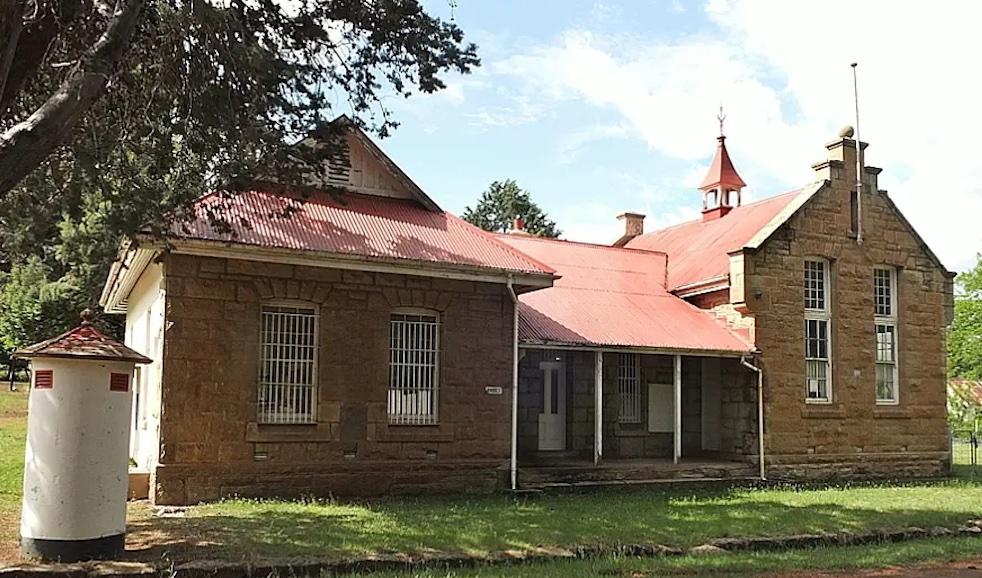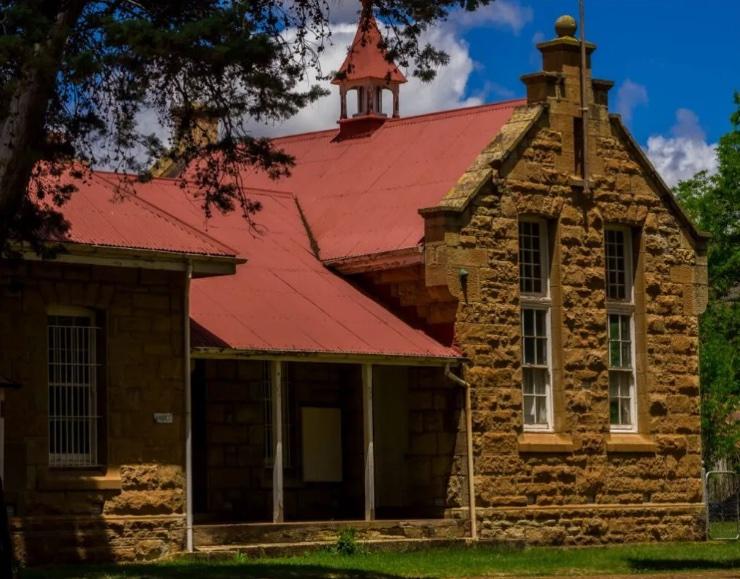
Disclaimer: Any views expressed by individuals and organisations are their own and do not in any way represent the views of The Heritage Portal. If you find any mistakes or historical inaccuracies, please contact the editor.
The Rhodes Post Office and Magistrates Court, a favourite with photographers, is a landmark within the Rhodes Heritage Area. Here is an early history of the building.
When Rhodes was established as a township on the farm Tintern in 1891, there was little need for a separate administrative centre. Barkly East was initially thought to be close enough. However, the village grew, especially after the erection of the Dutch Reformed Church in 1892, and the establishment of their Rossville Congregation in 1893. With several new businesses and an increased population, it became apparent that the five or six hour horse and cart drive to Barkly East, over a sometimes treacherous road, necessitated an administrative centre in Rhodes itself.
Rhodes became a municipality in 1897.
By 1896 the Cape Colonial Government had already envisaged a “Rhodes Court Room, Lock-up and Post Office” building.
The site in Rhodes, Erf 223, on the corner of Church and Naude Streets was purchased in 1897. The Lot is 535 m2.
Tender notices were invited for ” … the creation and completion of New Public Buildings at Rhodes, including Lock up, Post and Telegraph Office, Court Room and Special Justice Office”.
The tender notice clearly indicated: “The lowest or any Tender [will] not necessarily [be] accepted”.
In the end, only two tenders were submitted. Both were rejected as being too high, with the Report of the Chief Inspector of Public Works of 1901 noting that ” … the buildings were in consequence commenced departmentally in August 1898″.
The building was designed by Henry Sidon Greaves, in charge at the time of all architectural work executed by the Cape Public Works Department (PWD).
The Report indicates that the project was twice interrupted. Firstly, “owing to the depressed finances of the Colony the work was stopped” and secondly, with regard to the ongoing Second Boer War (also known as the Anglo-Boer War or South African War). The Report continues:
In April 1899 building operations were resumed until November the same year, when the district was invaded by the Republican Forces and proclaimed Free State Territory. All loyal subjects, including the officers and men engaged on the works, were expelled, and the buildings again had to be abandoned for a time.
These were the forces led by Commandant Jan Hendrik Olivier, notable for being the main Boer leader at the Battle of Stormberg, December 1899.
The building was at last completed. It opened in August 1900, “with a considerable saving on the tender received”. In recognition of this, a letter in the archival collections of the PWD in Cape Town, signed by Greaves, proposed that special bonuses be awarded to the works foreman, a Mr Bate, and his two assistants, Messrs Gellatley and Tannahill.
Part of the Post Office on the left. Verandah with Magistrates Office behind. Courthouse to the right. (Walkerbouts Inn)
The Report goes on to say that ‘the Postmaster took possession of his new quarters on the 1st July'. That there is mention of an unnamed postmaster is interesting, as it is generally accepted that the first postmistress was Miss M Smart. The postmaster has now been identified by post office historian Frits Aab as FW Bergmann, soon to be replaced by Miss Smart in August 1900. She held the position until her transfer to Tabankulu in 1901.
As to the design:
The Public Offices are rapidly nearing completion. They are well and substantially built, although somewhat quaint in design, and quite out of the ordinary run of buildings of that description. (Barkly East Reporter 13 Oct 1899).
Victorian Classicist Building. Asymmetrical composition. Although Post Office and Magistrate’s Court are housed in one building, importance of different functions are clearly expressed in form; Courtroom has Renaissance gable with Victorian ventilator turret on double pitched roof; Main facade facing Naude Street in dressed stone; Other sides painted plastered brick; Courthouse very attractive interior and old fireplace in magistrate’s office; Group value with Church. (Rhodes: conservation of a unique South Africa town p. 83)
The drawings and notes by the University of Natal School of Architecture students that make up Rhodes: conservation of a unique South African town include a grading for each building surveyed. These were based on the following criteria: architectural quality; historical association; environmental contribution; usability or adaptation; integrity of the original design.
Further detailed criteria were assessed in four grades: Excellent, Very Good, Good, Fair/Poor. This gave a final grade out of 100.
The Post Office and Magistrates Court (or Courthouse) was one of only 15 buildings awarded an “A”.
75-100 points: A – Preservation
Buildings of major importance which should be preserved (the building should be protected from alteration or further deterioration and under no circumstances be demolished).
The old Rhodes School was declared a Provincial Heritage Site (1987) within the existing Rhodes Heritage Area. This enhanced status of Provincial Heritage Site could give the Rhodes Court Room, Lock-up and Post Office building better recognition within the broader heritage community, confirming its historical and tourism value to Rhodes Village and surrounding areas.
With thanks to Frits Aab; Dr Gustav Hendrich, Western Cape Archives and Records Service, and the staff of Cory Library, Rhodes University, Makhanda.
Note: Rhodes is the official name of the village. It is often popularly referred to as “Rhodes Village” to differentiate it from other places named Rhodes.
Sally Schramm is a retired research librarian, with a career that included positions at the South African Library in Cape Town and the Cory Library at Rhodes University in Makhanda (formerly Grahamstown). She holds a BA in African History and Social Anthropology. Postgraduate qualifications are an Honours in Library and Information Science (UCT) and the Programme in Archival Studies (UNISA). Heritage Conservation, and Introduction to Museology, were short courses taken through the Stellenbosch University Museum. These courses were presented in conjunction with Historical Homes of South Africa Limited. When head of the Margaret Smith Library at the South African Institute for Aquatic Biodiversity (SAIAB), she completed the Heritage Digital Campus (Africa Media Online) and workshops by the Biodiversity Heritage Library (BHL). BHL is a consortium of natural history and botanical libraries that cooperatively digitise the legacy literature of biodiversity, making this available for open access and responsible use as a part of a global “biodiversity commons". The Margaret Smith Library is a founding member of BHL: Africa. As a part-time resident of Rhodes Village near Barkly East, she previously chaired the Rhodes Aesthetics Committee.
Comments will load below. If for any reason none appear click here for some troubleshooting tips. If you would like to post a comment and need instructions click here.

